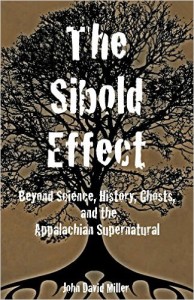★★★★ 
The Sibold Effect: Beyond Science, History, Ghosts, and the Appalachian Supernatural by John David Miller is a comprehensive look at supernatural activity at Clover Hollow in the Appalachian Mountains. Purchasing a property in the area, Miller discovers that the property actually belonged to his ancestors, raising questions about the nature of coincidence, destiny, and how history is shaped by forces we cannot see. A thoroughly-researched and intriguing look into the paranormal and how it affects people both personally and historically.
John David Miller is an expertly detailed writer with an engaging voice. His interests in the region are varied – he’s not merely interested in supernatural activity. The Sibold Effect takes a broad-based approach to the subject, as we learn about topics as far reaching as the Big Bang, geology, American politics, Native American history, and the history of the Sibold clan. Each sequence is informative and well-presented.
The trouble is that Miller doesn’t always effectively weave his topics seamlessly together, as if the book is several tomes in one. Miller begins the book by discussing the amazing coincidence of buying a property in the Virginia woods that somewhat miraculously has a long historical connection to his own family. Something has drawn him to this place beyond just his ancestry, one that is pushing him to delve into Indian folklore and the supernatural. It’s an awesome premise from which to begin his book.
However, from there, Miller provides a lot of information that doesn’t exactly relate to the book’s major claims. Though all of the topics are interesting on their own, they seem extraneous to the book’s premise, as if Miller thinks by adding historical detail to his work, it will make his supernatural claims more believable. While it’s interesting to read about how George Washington passed through the area, for example, it doesn’t have a lot to do with Miller’s later claims.
Miller mentions a love for Erich Von Daniken’s Chariots of the Gods, which posits that ancient man-made structures were constructed with extraterrestrial involvement. Miller is attempting to do something similar here – tying together history with the supernatural. If so, a lot of the information he provides – such as his detailed family history – seems more for his family to read than for those readers who are looking for proof of supernatural claims.
Additionally, the claims themselves are fascinating at their root, but don’t entirely work as presented here. Miller talks about videos he’s taken, which are posted at his site virginiarockart.com, but without aid of watching the videos, it’s less effective than being told something is a “spirit” without seeing exactly what he’s referring to. It would seem that this material would be best served as a documentary to fully incorporate all the information at the author’s disposal.
These criticisms aside, Miller’s earnest open-mindedness makes him an enjoyable narrator, and, as stated, the book is highly informative about a bevy of topics – especially strong about Native American history. If the book were pared down to focus on the supernatural claims at the very end of the book, while integrating the history covered early on, the book would be stronger and more persuasive. As it is, this is an eye-opening look into the potential for supernatural activity in the Appalachian mountains, but there is so much extra information that it complicates his premise, rather than making it more believable.
Links
Author Site
Facebook
Amazon
Createspace
Goodreads
Review Overview
Design
Editing
Content
Get an Editorial Review | Get Amazon Sales & Reviews | Get Edited | Publish Your Book | Enter the SPR Book Awards | Other Marketing Services























Leave A Comment